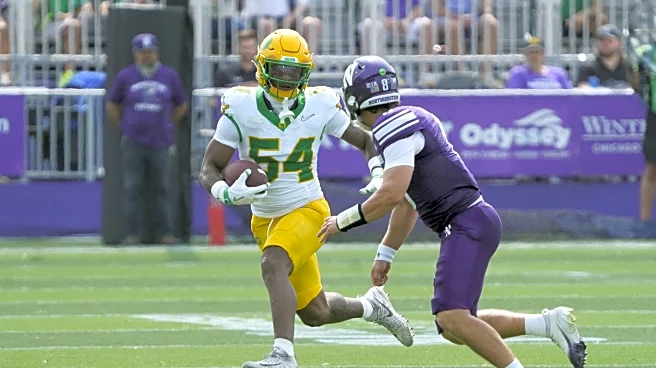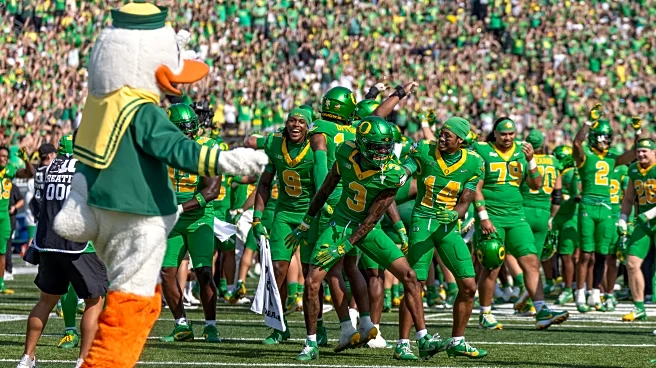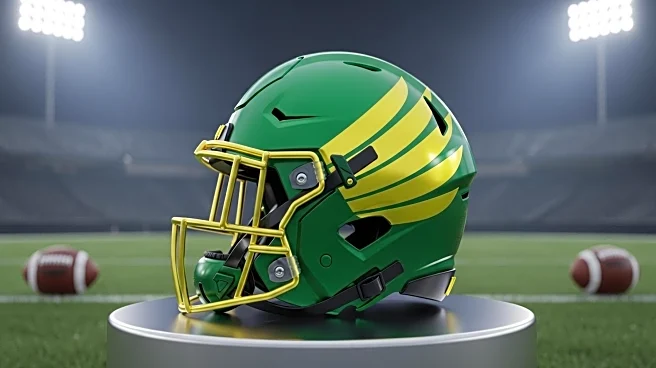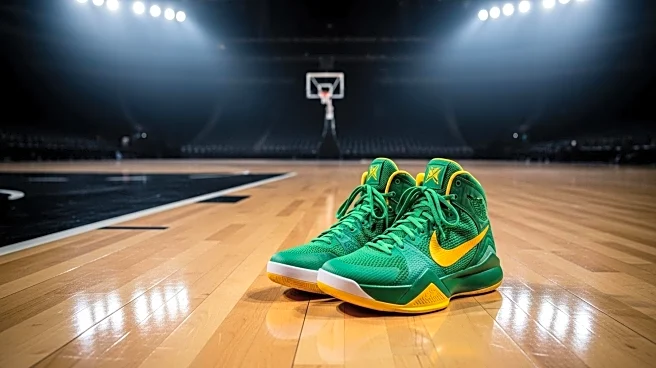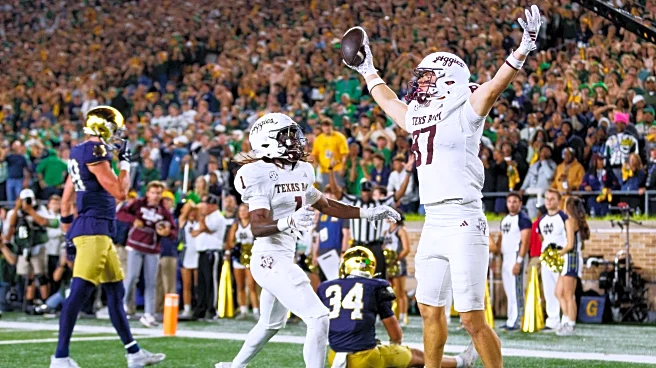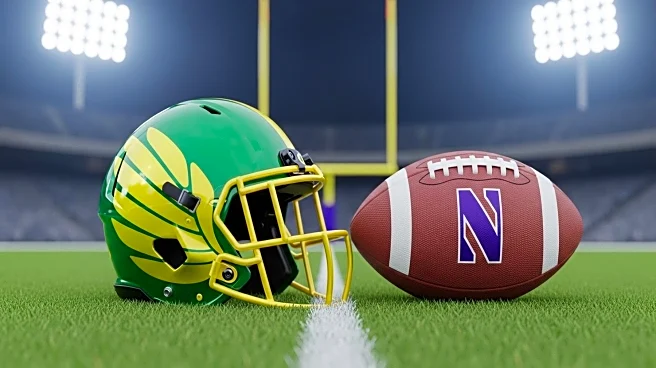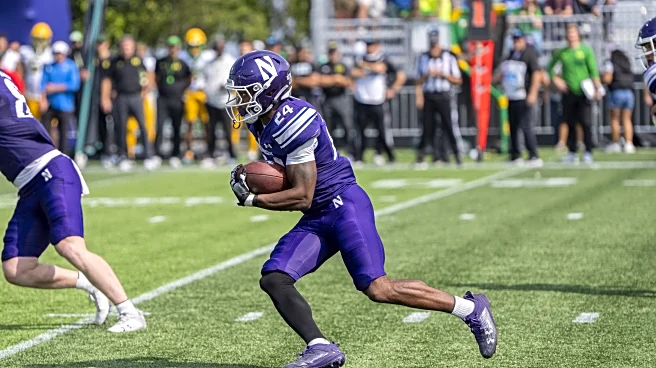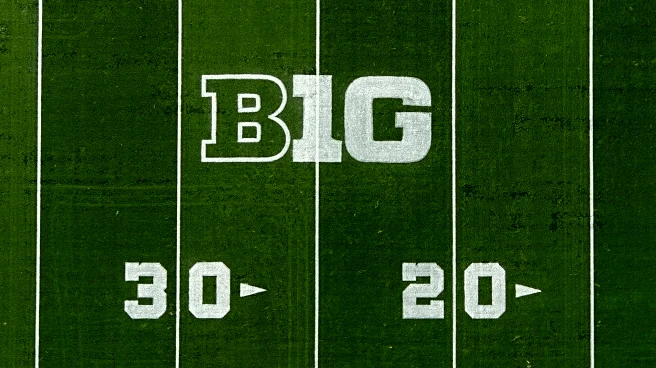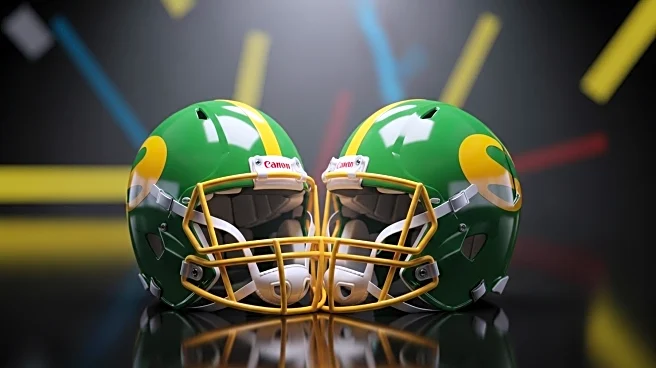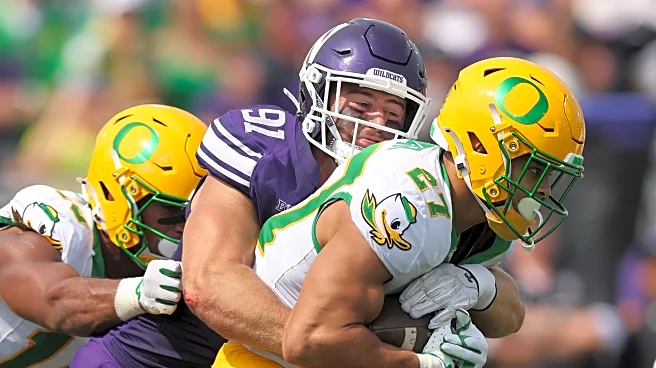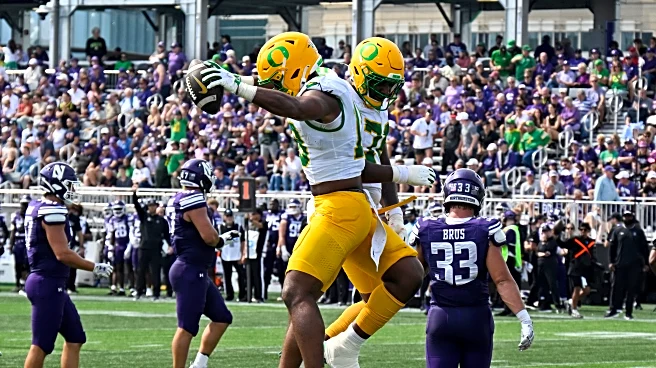The game entered garbage time after Oregon’s sixth possession as the Wildcats weren’t going to have enough possessions to overcome a 31-0 deficit late in the third quarter. Northwestern had only five meaningful possessions before then, only three of them went far enough to meaningfully change field position. Those three long drives twice ended in interceptions, and the third on a failed 4th down conversion that had the same effect as a turnover. Combined with an unforced fumble that stalled progress
on a fourth drive that was near midfield, the Wildcats never gave themselves a chance to keep the game close.
That the Wildcats kept making drive-ending mistakes which handed the Ducks the ball, and the Ducks paid off high leverage moments with explosive plays that the Wildcats couldn’t stop, resulted in a far larger scoreboard disparity than the underlying stats would have indicated.
Oregon’s first offensive possession stalled just after crossing midfield. Each of the next five possessions ended in scores, four of which were touchdowns. Two of those drives were short fields following turnovers and one was a single explosive play. Three of the Ducks’ six possessions were methodical full-field drives (they started in normal Oregon territory and weren’t dependent on any giant 30+ yard plays) and comprised one empty possession, one field goal, and one touchdown … mixed results.
Casual fans might look at the box score of Saturday’s game and cite such euphemisms as “it was a body clock game,” “they started slow,” or “they were sleep walking” when describing Oregon’s performance. A closer look at the film however showed troubling performances along the line of scrimmage on both sides of the ball, which I detail below.
OFFENSE
The offensive line was a major question coming into the season and the week 1 rushing performance against Montana State appeared to vindicate those concerns. There was significant improvement in week 2 against Oklahoma State, but there was always a possibility that was more of a product of the competition than a true indicator that the line had substantively improved. Given their performance against a deep and productive Northwestern defensive front (detailed in hythloday’s preview), it appears the Cowboys may simply be that bad of an FBS team. Based on this most recent game the offensive line has a long way to go be FBS average, let alone meet the standard of lines in Oregon’s recent past.
To illustrate this, I have added “interior” run stats to the normal performance metrics used in ATQ’s modelling. The exact definition of what constitutes an “interior” run can get murky, as even a play where the offensive line and ball carrier begin moving laterally can be considered as such if the runner cuts upfield between blockers. In general, any play that I have labelled “between the tackles” on my tally sheet means the runner went through a gap between two linemen or just off the outside shoulder of the end lineman (“off tackle”).
There were only three true perimeter runs before garbage time, two of them (a “wildcat” with two QBs on the field and a pitch on the goal line running opposite the other 10 players on offense) unusual enough I briefly considered calling them “trick” plays rather than runs. We saw none of the fly and/or jet sweeps that were used in the first two weeks. Furthermore, film review hythloday had noted that Northwestern’s linebackers were vulnerable to cut back runs and in pass coverage, especially against 12-personnel when they robotically substituted a third linebacker for the nickel defender. The Ducks only threw one short pass out of 12 personnel and I only noticed one true cutback run on my tally sheet. This contributed to what I thought was a sub-par game plan. After some consideration I came up with three possible causes for this:
- Oregon’s scouting and analytics department were, at least for one week, worse at their job than hythloday working alone.
- OC Will Stein was too stubborn and/or lazy to customize the game plan against what appeared to be an over matched opponent.
- Oregon’s staff decided they wouldn’t need to score many points to win and wanted to test what the offense was capable of without play calling advantages against the best defensive front they will see before Penn State.
Since the first two are ludicrous, the third must be true.
Northwestern has as much proven depth on their defensive line as Montana State did, along with a higher overall talent level. Oregon was above water in efficiency, but only because of the backs being able to improvise or break tackles. When the line’s technique was sound they found success, but that wasn’t often enough to feel totally confident going forward. Below is a representative sample of successful rushing plays.
(Reminder: you can control the playback speed by using the gear icon in the lower right of the player.)
- :00 – This is the only cutback run I found that was able to use the Wildcats’ aggression against them, and I don’t think it was even planned. Neither the RG nor RT make good contact with their assigned defenders, but they both get upfield so fast they run themselves out of the play. The center, #72, should move up the linebacker on this “fold” block after he maneuvers around the guard, but instead gives TE #9 Ja. Johnson an assist he didn’t require. The back, #27 Limar, makes chicken salad out of you-know-what by cutting to the middle of the field where overpursuit from the defense has left room to run.
- :12 – There is confusion on the left side of the offensive line (note the RPO to Sadiq on the offense’s right, the QB makes the correct decision to hand off). The LT needs to stay on the defensive end, but releases him to take on the blitzing nickel who won’t be able to affect the play if the blockers execute their assignments correctly. There is a mix up by double team at LG and C as both try to advance to the linebacker. The center, #72, needs to take the DT while the guard, #75, needs to chip and advance to the ‘backer. That same linebacker splits both blockers to make the tackle, but RB #20 M. Hughes gets low to burrow for five yards and a first down.
- :20 – This is one of the line’s better reps. The RG #74 needs to get his helmet playside of the defender rather than helping the RT. Fortunately the rest of the line has opened a gap big enough for Limar to sidestep the defender in the hole. Quick reaction from the safety saves a possible touchdown.
- :28 – This was the only play prior to garbage time that I didn’t have any negatives for the line when they needed to run block. Oregon is in a jumbo package with 236 lb. freshman #0 J. Davison behind FB #44 Z. Grace. There are six linemen on this play, RT G. Wilson is lined up as a tight end wearing #35, but he is covered up by #9 Ja. Johnson. The right guard #74 D. Iuli pulls to kick out one linebacker and Grace takes on another in the hole as the line washes down the front.
A combination of technique and assignment errors plagued Oregon’s front throughout the day. This is exactly the sort of difficulty the transfer portal effect predicts. The good news is that the coaches and players can work to make incremental improvements in these areas over the course of the season. The bad news is they’ll need to progress every single week without fail to be ready for the post season. Here are some examples of failed rushing plays.
- :00 – Another goal line situation, but more typical 12-personnel out of the shotgun. The center and LG get a good push, but that’s it. The right tackle gets high out of his stance and is driven back. The rest of the blockers are driven back or stalemated so there is no gap to run through.
- :07 – No longer in the red zone, this should be a straightforward inside zone run against a light box. Limar wants to run to the right of the center because the boundary safety doesn’t have any pass coverage responsibilities to keep him occupied. That isn’t an option though. Right tackle #71 loses his man when he doesn’t keep his weight over his feet. The NT occupies the hole the runner wants because RG #74 can’t keep his helmet play side even with a chip from the center #72, who proceeds to lose his balance trying to get up to the linebacker. Limar has to cut back to the offense’s left where the safety is ready for him.
- :16 – It only takes one missed block to turn a successful play into lost yardage. This looks like an off-tackle play where Limar is supposed to follow pulling LT #76 I. World around to the offense’s right. That part works out fine, but the boundary DE is too quick for TE #18 and runs Limar down from the backside.
- :23 – Once again, one failed assignment makes all the difference. The RG gets high out of his stance and his man makes the tackle before Limar can take advantage of the hole forming in the A-gap on the offense’s left. It doesn’t help that LT #76 bends his back and can’t move his man so he nearly trips TE #18 K. Sadiq slicing across the formation to seal the backside defender.
Dealing with injuries and some questionable decisions regarding personnel use in the secondary, the Wildcats struggled to stick to the Ducks receivers. This wasn’t quarterback Dante Moore’s cleanest game, but he still flashed the upside that has fans, and pro scouts, so intrigued. Below is a sample of successful pass plays.
- :00 – So far this season the Ducks are calling screen passes at less than 10% of offensive plays, well below last season, and this week succeeded on 2 out of 3 such plays. The blockers on this bubble screen, #2 G. Bryant Jr. and #11 J. McClellan, make enough contact to open a lane for dynamic freshman #1 Dak. Moore to get a first down.
- :11 – On second and long Northwestern has their linebackers drop deep and tries to generate pressure with a T/E stunt to the offense’s left. The stunt is handled well by the protection so Moore has a clean pocket, and he knows the underneath routes will be open when he sees the ‘backers bail deep. It would have been easier running for WR #17 C. Perry if he turned to his right so McClellan could block for him, but he does well to set up third and short.
- :21 – The line and running back all pick up their assignments on this simulated pressure from Northwestern, so Moore has a clean pocket to work from. Having to bail from the line of scrimmage means the linebacker can’t gain enough depth to stop this accurate throw to #1 Dak. Moore.
- :39 – RPO’s were used as a significant part of the game plan. I had no errors for Moore on RPO reads. On this play he can see prior to the snap that #11 J. McClellan is 1-1 with the defender giving a soft cushion. I’d normally say McClellan should turn back to the middle of the field and dive forward for the first down, but he shows off an impressive stiff arm to gain extra yardage toward the sideline.
The offensive line had issues in pass protection as well as run blocking. The quick releases much of Stein’s playbook is built upon can partially negate edge pressure, but that can limit the playbook. Moore had a few balls he didn’t place well in this game. He also got a bit greedy a couple of times during this game (including his first interception, though that was during garbage time). Below are examples of failed passing plays.
- :00 – There is pressure right in the quarterback’s face as the left tackle’s assist actually helps the DT separate from LG #75. He would have been better off gaining depth to pick up any rushers coming into his area. Needing to get the ball away quickly to avoid a sack Moore throws toward his first read. The ball is too far away for any of the three defenders to get a hand on it but also not where the receiver thought he could jump for it. With another second Moore would have seen WR #4 M. Benson open for a touchdown on the deep post.
- :18 – Once again Moore has to contend with pressure as the left tackle slips then trips the left guard, and the back is looking the wrong way. There is still a chance for a completion, but perhaps due to the pressure the ball is placed too far outside for Benson to redirect and get it. The corner in coverage is NU #13, who hythloday noted was their most consistent pass defender. His technique is excellent as he never grabs the receiver or pushes off while playing the ball.
- :41 – The quarterback may be sensing the pressure coming from his right, but he still has time to step into this throw and deliver an accurate ball. It needs to be low and away to give his receiver a chance to separate from the defender. In this case the throw is high and #1 Dak. Moore would have landed out of bounds even if the defender didn’t break it up.
- 1:06 – The protection holds up pretty well at first, but none of the routes break open. Moore tries to buy time by backing up, but that just makes it easier for the defenders to get a bead on him when the protection finally fails. He escapes to his right and avoids a sack. If he had spun out to this left earlier he might find #18 Sadiq breaking open, or at least had more room to run.
DEFENSE
Northwestern ran 37 plays prior to garbage time, almost evenly split between 18 rushes and 19 passes. Oregon’s defense was below water in efficiency at 45.95%, but Northwestern had one explosive play prior to garbage time and averaged only 5.23 yards per play. While 37 total meaningful plays is a bit under the usual threshold for rush and pass splits, the difference in efficiency was so striking it’s worth mentioning regardless: the Ducks’ rushing defense posted a terrible efficiency of 33.33%, as opposed to pass efficiency defense which was one play away from championship caliber at 57.89%. In yardage, the Wildcats averaged 4.42 YPC on the ground, pretty middling (and very similar to the Ducks’ own interior run number), but through the air they got less than one yard more at 5.36 YPA, a far below median passing number.
In other words, Northwestern by a large margin outperformed Oregon in the efficiency run game on both sides of the ball, but Oregon outperformed Northwestern at everything else – explosive rushing offense and defense, and all forms of passing in both directions.
I’m left to conclude that the Wildcats best plan would have been to employ a classic Big Ten style strategy and simply take the air out of the ball. Their offense wasn’t getting the explosive plays from the passing game to justify the loss of efficiency. As it was, all six of Northwestern’s scoreless drives prior to garbage time ended with a failed passing play.
Oregon’s defense did an excellent job not letting any of the Wildcat’s successful runs break open into the secondary. Even “curving” the rushing efficiency to reflect short successful gains in situations where the Ducks’ mint front defense prioritizes defending the pass wouldn’t get the rush efficiency defense above water though. Here’s a sample of successful rush defense.
- :00 – The three defenders on the line of scrimmage to the offense’s left get their helmets playside to force the run back toward the middle of the field. Both DT #52 A. Washington and #1 B. Alexander (lined up at 5-tech against 12-personnel from the Wildcats) get off their blocks to join linebackers #28 B. Boettcher and #54 J. Mixon for the tackle.
- :07 – Northwestern used quite a lot of this heavy pistol throughout the game. On this play the on-ball defenders keep the interior running lanes clogged. The back runs into big DT #50 T. Gray but keeps his legs churning until ‘backers #9 B. Purchase and #26 D. Jackson arrive to clean up.
- :17 – I did some more research after posting last week’s recap and realized this alignment with S #31 D. Thieneman 10 yards deep in the middle of the field is a variant on a classic Tampa-2 look that allows three deep defenders against the pass. Against a run he is still able to come down and defend the run, though OLB #44 T. Tuioti (to the offense’s right) has already grabbed the runners legs.
- :24 – By the third quarter Northwestern had already gotten a lot of yards running this basic outside zone. Note a now healthy CB #5 The. Johnson at boundary corner to the offense’s right lined up against his former team. The run heads his way but OLB #9 B. Purchase sets the edge. At DT #50 T. Gray is driven back but gets loose to close off the cutback lane before DT #1 B. Alexander and LB #28 B. Boettcher mop up
Many of the Ducks’ defenders are listed at noticeably higher weights this season. This made sense as efficiency rush defense was a weakness for Oregon last year and the mint front addresses this by having big bodies in the middle of the field to spill runs to the edge. In this game though, I had far too many instances on my tally sheet of defenders playing with poor leverage and getting moved by double teams. Inside linebacker #26 D. Jackson also showed up in the wrong spreadsheet columns a significant number of times. Some examples:
- :00 – All of the playside defenders on the LoS are slanting to the offense’s left, so #26 has to defend the A-gap by attacking the guard’s inside shoulder. When he goes outside he gets walled off from the back. Safeties #31 D. Thieneman and #21 A. Flowers prevent a bigger gain.
- :08 – The field side linebacker #54 J. Mixon has responsibilities in man coverage so he can’t play the run at the snap. The NT #52 doesn’t execute his two-gap responsibility properly, getting trapped with his helmet toward the boundary. The boundary safety #2 K. Lopa is coming down in run support but has a poor angle to the B-gap on the offense’s right and can only prevent an explosive play.
- :27 – This is a variant on the classic “power play” with a guard and the H-back pulling to the offense’s left. The edge defender #9 needs to attack the pulling guard’s outside shoulder to force the run inside to his help. When he loses contain it allows the receiver NU #19 to block #26 Jackson who is in pursuit and the safety #31 Thieneman compounds it all by breaking down poorly and allowing the back to escape to the sideline as the corner #4 escapes some Big Ten blocking in time to miss a tackle.
- 1:00 – The Wildcats didn’t use this “diamond” formation with two tight ends often, but ran the ball when they did. The linebacker to the offense’s left, #54 Mixon, tries to get around the guard rather than engaging his outside shoulder. The blocker politely obliges by escorting him out of the play. In the middle of the line DT #52 gets his shoulders turned perpendicular to the line of scrimmage and LB #28 is late to trigger.
In contrast to their performance against the run, Oregon’s pass rush was frequently disruptive. As hythloday had documented, Northwestern QB Preston Stone did not handle the pressure well and made critical errors that ended 5 of the Wildcats’ 6 drives (the sixth was an accurate pass that was dropped by the receiver). Below is a sample of successful pass defense:
- :00 – The pass rush executes a pair of stunts that pushes the protection back into the quarterback. Stone has a chance to spin out to his left to buy time, but instead he tries to force the ball to the closest receiver. Boettcher follows the passer’s eyes and nearly gets an interception. He’d pay off another chance later in the drive.
- :15 – The broadcast conveniently highlights #10 M. Uiagalelei just before he hurries Stone into a throwaway on third and long. There is a short crosser open over the middle but no clear throwing lane and defenders ready to tackle the catch short of the sticks.
- :22 – The Wildcats tried to buy Stone some time using seven blockers in pass protection a couple of times but it never paid off. On this play the linebackers get sucked up by play action, but there are still five defenders in coverage against only three receivers. Stone is too eager to get the ball away before the protection fails and forces another throw that is deflected by CB #4 B. Finney Jr. and almost intercepted.
- :32 – The Ducks send an extra pass rusher and the Wildcats line doesn’t adjust. With Uiagalelei coming right at him, Stone does the smart thing and tries to get the ball to his running back. He avoids the sack, but Uiagalelei smartly gets his hands up for a deflection.
As has become a theme so far this season Oregon trusted their young secondary to hold up in man coverage. They usually did, but there were a few breakdowns. The few times he had a clean pocket, Stone showed what he is capable of as a thrower. Below are examples of failed pass defense:
- :00 – On this play the protection is only beginning to break down at about 3 seconds after the snap. That is enough time for Stone to see that LB #26 has continued to bail deep rather than pick up the running back in the flat.
- :09 – This play action bootleg works as intended and pulls both inside linebackers out of position. The outside ‘backer #9 is now in conflict as he has to worry about the QB scramble and the tight end in the flat. The safe play is to stick to the TE in coverage. When he rushes the passer, Stone puts the ball over the top of him.
- :30 – A stunt on the offense’s left is closing in on the QB, but he has just enough time for the his favorite target, NU #17 Wilde, to break open on the crosser. The linebacker in coverage, #26, seems to be staring down the quarterback rather than watching the routes develop. He needs to see the mesh concept developing and attack the underneath route.
- :40 – When the Ducks send a five-man blitz it leaves Northwestern’s best receiver running an out route against single coverage. Stone is staring him down the whole time, which is fine against man, and the corner #7 simply loses this rep. Watch this again and see #28 Boettcher and #4 Finney show how to properly defend a mesh concept.
